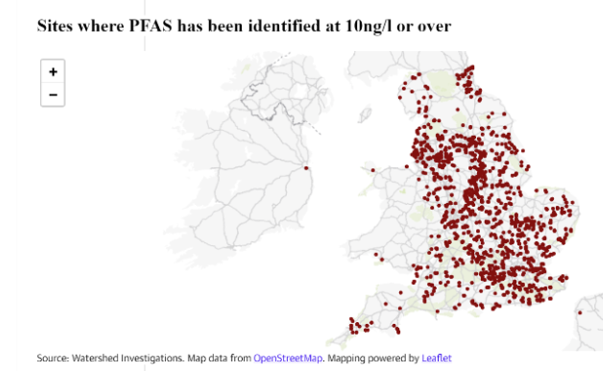PFAS: A Long Lasting Legacy

PFAS are a group of toxic chemicals found across the globe. They have permeated into the environment, our food chain and are estimated to be found within 90% of the global population. They are known as forever chemicals because they don’t break down easily and are therefore likely to leave a long lasting legacy within our environment.
PFAS (Poly and perfluoroalkyl substances) represent a group of approximately 12,000 chemicals that are used for their indestructible and non-stick properties. These same properties mean they are highly persistent and mobile. As a result they are shown to bioaccumulate (build up in concentration especially up the food chain) in organisms.
There’s clear evidence that PFAS are accumulating in our oceans, wildlife and our bodies. Their widespread use is creating a toxic legacy.

PFAS are found in aquatic environments throughout the world both in water and biota. They are almost inescapable. Firstly, they are used in so many of our everyday products such as stain, fire and water repellent textiles, non-stick pans and packaging.
Secondly, because they have been used so abundantly since the 1940s they now have also pervaded into our ecosystems through landfill leachate and industrial processes, fire fighting foams and more. CL:AIRE has recently published Technical Bulletin TB22 (March 2023) listing some of the key activities that could be key continuing sources. As a result they are in the water that comes out of our taps and the food that we buy from the supermarket.
Industrial sources of PFAS
| Fire-fighting (AFFFs and as fire suppressants) Military basesAirfieldsFire fighting training grounds Metal finishing and plating Hydraulic fluids fluoropolymer productionPaper products and packaging paper millsphotographic development studios, in printing facilities where inks are used in photolithography Semiconductor manufacturing Manufacturers of textiles, leather and apparel (including carpets and furniture) | Cleaning products (including industrial surfactants) Refrigeration Waste water treatment worksLandfillsLand spread with sewage sludgeFluorochemical, rubber and plastics industries Aviation/ Aerospace IndustriesSurface cleaners, car waxes and treatmentsCoatings, paint and varnish industriesBuilding and construction – weatherproofing, anti corrosion and stain resisting materials. |
Once these contaminants are being used industrially or within the everyday goods that we use they will disperse into our environment as shown in the source pathway receptor model below. Further details of which can be found in CL:AIRE TB19.
Sources of PFAS and pathways for environmental exposure1

Source Pathway Receptor model showing the movement of PFAS through our environment. – Image source: Chief Scientist’s Group report, August 2
Types of PFAS
PFAS are a chemical group and within that there are several specific chemicals of note, both of which are perfluoroalkyl acids (PFAAs): perfluorooctane sulfonic acid (PFOS) and perfluorooctanoic acid (PFOA). Interest is widening to include shorter chain PFAS, PFAA precursors and perfluoroalkyl ethers.
Toxicity of PFOS
Worryingly, research carried out in America suggests that PFOA has been linked to high cholesterol, ulcerative colitis, thyroid disease, testicular cancer, kidney cancer and pregnancy induced hypertension. Whilst PFOS has been linked to problems with the immune system, low birth weight and birth defects.
As a result of this research there is mounting concern about this chemical and hence more research and regulation is likely to follow over the coming years.
The scale of the problem
The UK Drinking Water Inspectorate has specified a limit of 100ng/l. If this is exceeded, the water companies must immediately act to reduce levels.
A map has been created to identify where PFAS are located across the UK. This is based on information from Water companies, Drinking water, EA groundwater and rivers, CEFAS sediment and fish samples.
Approximately 17,000 sites across the UK and Europe have been found to have PFAS. At 640 of these sites PFAS have been found at concentrations of more than 1,000ng/litre. At 300 locations, levels have been found >10,000ng PFAS. At the River Wyre the highest levels were found of 12000ng/l in discharge from a chemical plant.

Image source: The Guardian article: Revealed: scale of ‘forever chemical’ pollution across UK and Europe
“These sorts of concentrations raise concerns with me,” said Prof Crispin Halsall, an environmental chemist at Lancaster University. “You have the risk of livestock gaining access to those waters and [then PFAS is] in the human food web.” Halsall says there are also risks involving people “accessing wildlife as food sources like fishing and wildfowl”. (Guardian, 2023)
What can be done? – Regulation, Remediation, Data
Regulation
- In the UK currently of the 12,000 PFAS only PFOA and PFOS are regulated in soils These are regulated under Soil Screening Values (SSVs). PFOS and PFOA have been published by the Environment Agency with a screening value of 0.014 mg/kg.
- PFOS is listed as a priority hazardous substance (PHS) under the Water Environment (Water Framework Directive) (England and Wales) Regulations 2017.
- However, we are well behind Europe in our thinking and action in terms of regulation. The majority of PFAS are industrial and consumer chemicals that are regulated under the Registration, Evaluation, Authorisation and restriction of Chemicals (REACH) Regulation, this is European regulation (EC, 2006).
The UK is awaiting the outcome of a PFAS regulatory management options analysis (RMOA). These will consider the best way to manage risks posed by PFAS. This is being carried out by the UK Health and Safety Executive and the Environment Agency and began in 2020. We are expecting further regulation soon.
Remediation
With the rise in focus, new remedial processes are being devised. In America, Carey et al (2002) have reviewed a method using colloidal activated carbon (CAC) injection at PFAS sites. The conclusion has demonstrated that the injection of CAC to facilitate in situ PFAS remediation has been generally successful for both short‐and long‐chain PFAS in the short‐term (0.3–6 years). This could provide a solution for the long term clean up of this legacy of contamination.
Further remediation techniques are being discovered such as Canadian scientists at a university in British Columbia who have made a recent breakthrough and discovered a new method to absorb PFAS and to break them down.
Waste water treatment works can remove some PFAS from drinking water using activated carbon.
Data and assessment
We provide data and map packs including clear historical mapping, recorded pollution incidents as a result of fire as well as details of former permitting to enable the identification of the potential sources of ongoing contamination.
Our project consultants will review all pollution incidents as a result of a fire with the view that they could have a PFAS element, particularly following the mitigation of the fire or through potential materials on site. This is built upon the quality and quantity of our historical mapping and our pollution incident archive, in order to provide clients with the best possible appreciation of the potential for PFAS.
In Summary…
- PFAS are known to be toxic to humans and the environment. They are persistent and bioaccumulative and are creating a widespread long lasting legacy of contamination.
- The sources of these contaminants are also widespread and have been used in goods and industrial processes since the 1940s. There are approximately 12000 of these chemicals being used, only 2 of which are regulated in the UK.
- Within initial findings PFAS have been found at 17,000 sites. Six hundred and forty of these sites have been found to have potentially harmful amounts of PFAS.
- We foresee continuing voluntary action with large companies following suit with big manufacturers to remove the use of PFAS from their organisations.
- We also foresee an increased level of regulation over the next few years with an overall aim to eradicate these contaminants from product life cycles but also from the environment in the form of remediation.
- It would be prudent for landowners to begin managing the risk and liability of future legislation by reviewing the use of PFAS across a product or asset lifecycle.
- When managing potential risks from PFAS in the ground a site specific risk-based approach is necessary by identifying active source-pathway-receptor (SPR) linkages and ensuring suitability for end use.
- The approach may begin with portfolio risk analysis and site sensitivity screening to assess PFASs usage, site sensitivity and potential SPR linkages. Management of this could be part of the process of initial due diligence. Analysis to assess risk will need to take into account both current and future regulations.’
For more information on our approach and consideration of PFAS among other site contaminants as part of our site risk assessment and project work, get in touch at info@groundsure.com or call us on 01273 257 755.
References
- https://assets.publishing.service.gov.uk/government/uploads/system/uploads/attachment_data/file/1012230/Poly-_and_perfluoroalkyl_substances_-sources_pathways_and_environmental_data_-_report.pdf
- Ross, I., Hurst, J., 2019. Managing Risks and Liabilities associated with Per- and Polyfluoroalkyl Substances (PFASs). CL:AIRE Technical Bulletin TB19. CL:AIRE, London, UK
- https://www.theguardian.com/environment/2023/feb/23/revealed-scale-of-forever-chemical-pollution-across-uk-and-europe
- Longevity of colloidal activated carbon for in situ PFAS remediation at AFFF‐contaminated airport sites. Grant R. Carey. Remediation, 2022.
Date:
Apr 28, 2023
Author:
Clare Stepan

